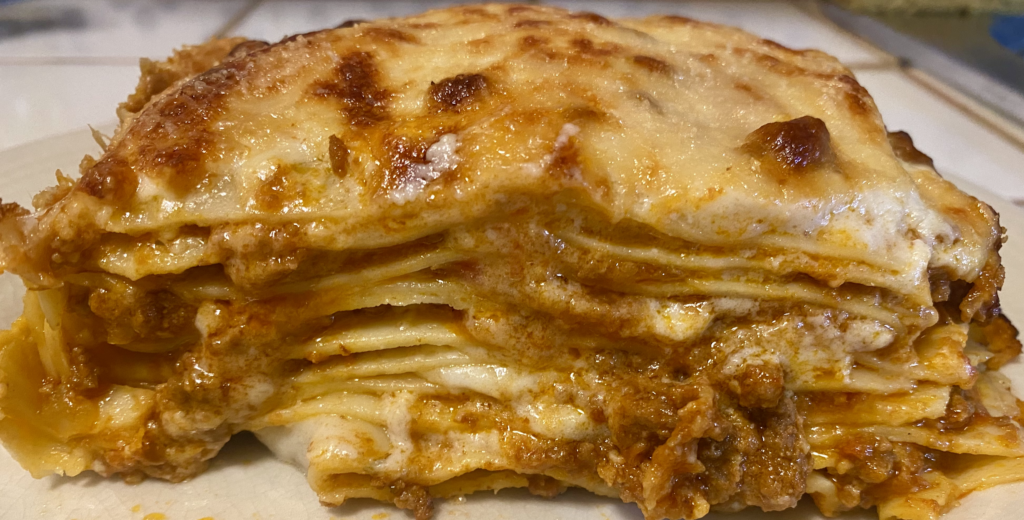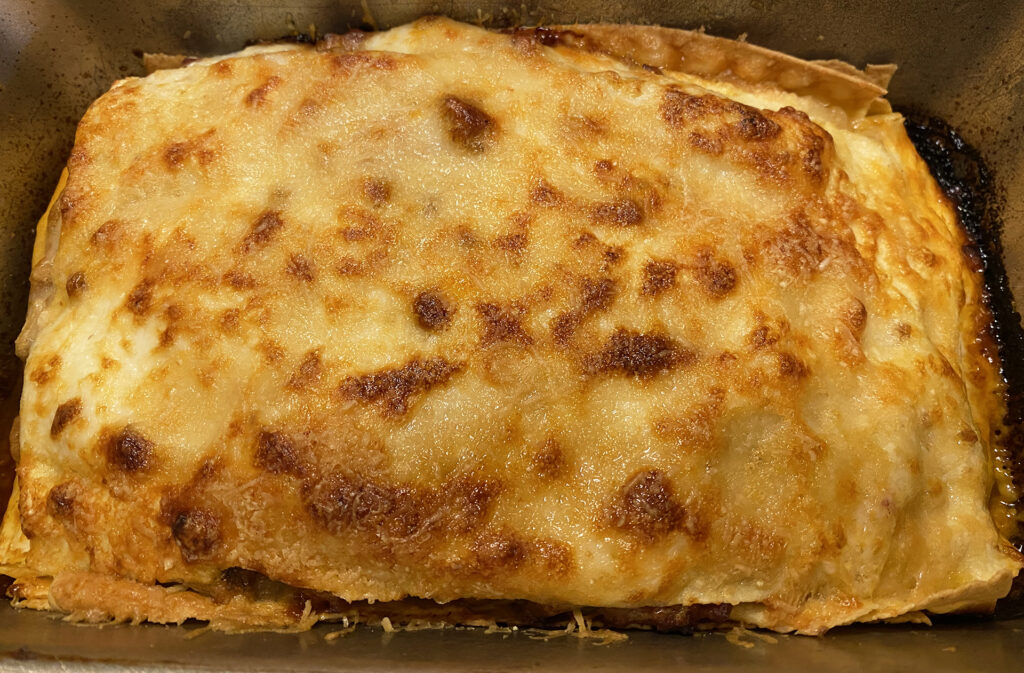
March 4, 2023. This is the ecstatic mouthful. One bite of ecstasy after another. Your tongue is dazzled. Your whole mouth is thrilled. So many flavors and textures. So deeply delicious and so completely satisfying.
It’s a combination of three favorite recipes: Bolognese sauce I’ve used on pasta and pizza; the Bechamel sauce I use for every gratin and for the amazing mac & cheese; and the Way to make pasta from scratch. Put them all together for something you really want in your mouth right now.
Alas, it’s gonna take a few hours. Some prep, some waiting. It’s worth it. Make it a project. The focus of a weekend afternoon that ends with the big bang of a spectacular dinner.
OK, now you might be reconsidering. You’re thinking, hey, lasagna. Big deal. You’ve had lasagna before. Yeah, it’s pretty good, but …
This is different. Unless you’ve had it in a great Italian restaurant where everything just came together in the kitchen a minute before it was rushed to your table. Where you wondered how lasagna could possibly be this good. How it could be great. This is how:
Make the Bolognese “Sauce”
This is the flavor bomb. This is the recipe. Takes about 40 minutes to prepare; then, it simmers for two or three hours. Which gives you plenty of time to
Make the pasta sheets
From scratch. Really. You can do this. Yes, you’ll need a small, simple hand-crank pasta machine. Once you’ve used it, you’ll be making excuses to use it again and again. Not just for the pasta sheets in your lasagna. You’ll be making fettuccine and spaghetti every which Way. You’ll be amazed. You’ll be proud. You’ll tell everyone who’ll listen. And then they’ll invite themselves over for dinner.
This is how you make pasta from scratch. Takes about 12 minutes to transform flour and eggs into fantastic fresh pasta dough. Then it rests for an hour. Then you crank it through the machine many times, on progressively thinner settings. Until you have translucent, paper-thin sheets of pasta. When you’re ready to assemble all the elements in your baking dish, you’ll boil the pasta sheets, one at a time, each for 60 seconds, no more.
The alternative: buy already-made pasta sheets. You can probably find “fresh” refrigerated or frozen ones in a good supermarket. Or you can use dried “no boil” pasta sheets like these.
Make the Bechamel Sauce
Here’s the recipe. Butter, flour and milk. About 5 minutes of whisking. If you’ve made any of the BCS gratin recipes or the transcendent Mac & Cheeses, you’ve done this before.
Grate the cheese
Finely grate one cup of good, dry parmigiano cheese, Reggiano if possible.
Put it all together. Timing is everything.
Preheat your oven to 375. Your Bolognese sauce has been simmering. You’ve cranked out your pasta sheets and cut them to size – the size of the baking dish you’ve buttered and are about to fill. It’s OK to use two or even three smaller sheets fill the dish wall to wall.
Now spread a thin layer of the Bolognese on the bottom of the baking dish. Just enough to cover the surface completely. Next, you’ll bring a shallow pan’s worth of water to a gentle boil while you’re whisking your Bechamel.
When the Bechamel is ready, gently place a pasta sheet in the boiling water. Cook it for no more than 60 seconds. Place it on top of the thin layer of Bolognese. Put another sheet in the water. You’ve got 60 seconds to cover the first sheet with a thin layer of Bolognese – and spread a very thin layer of Bechamel on top of it. Finally, sprinkle a very thin layer of grated cheese on this.
Now do it again and again: miraculously thin pasta sheet; thin layer of Bolognese; very thin layer of Bechamel; a dusting of grated cheese. Remember: the layers are thin. So you can have a stack of many, many thin layers. I had 10. The more very thin layers, the better the party in your mouth. After the last pasta sheet, just top it with a layer of Bechamel and then a final dusting of grated cheese.
Put it in the oven.
For 30 – 35 minutes. Until the top is a bubbling version of your favorite golden brown. Yes, it looks beautiful. It smells wonderful. But let it settle and set for 5 minutes. Then it’s time for ecstasy.

Cost-Benefit Analysis
The feeling of accomplishment: Priceless. About $2.50 per each of the four servings of this spectacularly fresh, tasty main course. Serve it with a salad dressed with oil and vinegar to lower the glycemic load of the whole meal. Or with some broccoli dressed with a squeeze of fresh lemon juice. The lemon is another GL-lowering ingredient – and so is the broccoli that also delivers a day’s worth of Vitamin A and two days of Vitamin C. Not to mention fiber and a range of phytonutrients and carotenoids, Vitamins E and K and other micronutrients including iron, calcium, potassium and zinc.
Cost Comparison
About $5 for two servings of your homemade masterpiece. Which add up to the same portion size as one serving of lasagna Bolognese at the Olive Garden, where you’ll pay about $20 for a bland, gooey three-layer version. Four times the cost of your infinitely Better pride and joy.
The Pasta Index
From the University of Sydney’s definitive Glycemic Index database: “Pasta has a low GI because of the physical entrapment of ungelatinised starch granules in a sponge-like network of protein (gluten) molecules in the pasta dough. Pasta is unique in this regard. As a result, pastas of any shape and size have a fairly low GI (30 to 60) … Pasta should be cooked al dente (‘firm to the bite’) … Overcooking boosts the GI. Although most manufacturers specify a cooking time on the packet, don’t take their word for it. Start testing about 2-3 minutes before the indicated cooking time is up. [Your fresh pasta cooks for only 60 seconds and has an even lower GI.]
“But watch that glucose load. While al dente pasta is a low GI choice, eating too much will have a marked effect on your blood glucose. A cup of al dente pasta combined with plenty of mixed vegetables and herbs can turn into three cups of a pasta-based meal and fits easily into any adult’s daily diet.“